Whether you’re furnishing a cozy home or a professional office, you’ll need to use the right materials. In turn, they’ll define both the aesthetics and the longevity of your pieces. It’s key to understand the various choices available, and their inherent qualities. This guide discusses the common materials used in furniture-making, so you can make an informed decision.
Hardwood: Elegance and Endurance
This popular choice offers unparalleled durability and timeless appeal. Woods like oak, maple, cherry, and walnut stand out for their robustness and resistance to daily wear and tear. Furniture made from hardwood tends to be heavier, signifying its solid construction and long-lasting qualities. It contains unique grain patterns, and you can finish hardwood in various stains and varnishes. This adds to its appeal, making every piece unique.
While it may cost more compared to other materials, its longevity and classic look often justify the investment. The Internet can make it much easier for you to find what you’re looking for. The people viewing the Flitch website for furniture confirm folks’ desire to search by categories, price, colour, and material. They want to view photos, take style quizzes, and read about dimensions and retailers.
Softwood: Light and Adaptable
In contrast to hardwood, softwoods (like pine, cedar, and spruce) offer a more affordable option. These woods are lighter and more pliable. This makes them suitable for furniture pieces that aren’t subject to heavy use. Softwood is ideal for pieces where aesthetics take precedence over durability. This includes ornamental carvings or specific style-centric items.
Their susceptibility to scratches and dents is higher. However, some people prefer rustic charm and enjoy frequently updating their furnishings. In these scenarios, softwood offers a budget-friendly and adaptable choice.
Metal: Contemporary and Resilient
The use of metal in furniture spans from iron and steel to aluminum. In turn, it caters to a more modern and industrial design ethos. Metal furniture stands out for its strength and ability to withstand a range of environmental conditions. This makes it a practical option for outdoor settings.
The heft of metal pieces can be a testament to their durability. While potentially more expensive, metal furniture is low-maintenance. It offers a sleek, contemporary look that can complement a range of interiors.
Glass: Chic and Modern
Glass brings a level of sophistication and modernity to furniture. It’s often used in tabletops and decorative elements. It pairs beautifully with other materials like metal and wood – offering a contrast that can elevate the overall design of a space.
The transparency of glass creates a sense of openness and lightness in furniture. However, it requires careful handling and regular cleaning to maintain its pristine appearance. The fragility of glass also makes it less suited for high-traffic areas, or homes with pets or young children.

Engineered Wood: Practical and Uniform
Engineered woods (including plywood, MDF, and particle board) are man-made options. They provide a uniform and often more affordable alternative to solid wood. These materials are created by binding wood fibers, particles, or veneers with adhesives. In turn, they form composite panels. Engineered wood is less prone to warping and splitting, offering a consistent and stable base for furniture.
It’s particularly useful for pieces with intricate designs or those requiring a smooth, paintable surface. It may lack the natural charm of solid wood. However, its practicality and versatility make it a popular choice in modern furniture manufacturing.
Plastic: Versatile and Weather-Resistant
Plastic furniture is particularly prevalent in outdoor settings and casual, contemporary interiors. The material is lightweight, making it easy to move and rearrange. Plastic can be molded into a vast array of shapes and comes in a multitude of colors.
This allows for creative and playful designs. Plastic is durable in terms of weather resistance, although it may not bear the same weight or offer the same longevity as more traditional materials.
Fabrics and Upholstery: Comfort and Personalization
These elements add coziness and a personal touch to furniture. The choice of material can range from natural fibers (like cotton and leather) to synthetic ones (like polyester and velvet). High-quality fabrics can withstand wear and tear. They offer easy cleaning options and contribute significantly to the aesthetics of a piece.
The durability of such furniture also depends on the structure beneath the upholstery. This makes it essential to consider both the fabric and the frame in your selection.
The material of your furniture is more than just a matter of appearance. It’s also about quality, durability, and suitability for your lifestyle. With the right choices, your home or workplace can become both practical and stylish.


